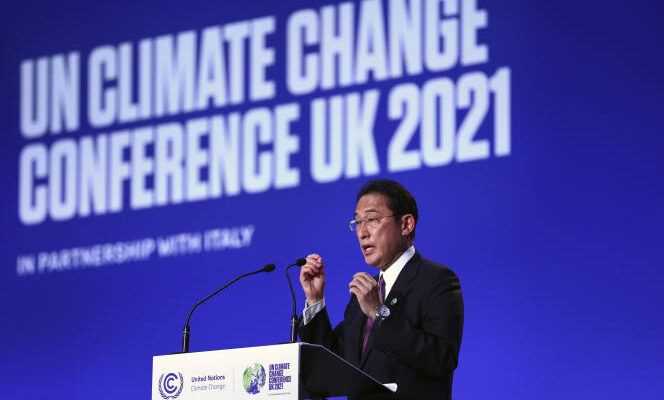Japan made a commitment on Tuesday, November 2, during the 26e Glasgow World Climate Conference (COP26), to release $ 10 billion over five years to help Asia achieve the goal of carbon neutrality and $ 240 million (€ 207 million) for the preservation of forests. However, this announcement struggles to mask the limits of the environmental policy of the Archipelago, the world’s fifth largest emitter of greenhouse gases (GHG).
” Japan will continue its efforts to achieve net zero emissions in Asia, the engine of global economic growth ”Prime Minister Fumio Kishida said on a whirlwind visit to Glasgow. Wishing to demonstrate the voluntarism of his country, Mr. Kishida also confirmed the commitments made in October 2020 by his predecessor, Yoshihide Suga, for carbon neutrality by 2050, and in April to increase to 46%, against 26% previously. , compared to 2013 levels, the GHG reduction target by 2030.
To achieve this, the Ministry of Economy, Trade and Industry (METI) unveiled at the end of October the sixth national energy plan, which sets the share of renewables in the energy mix from 36% to 38%. by 2030, against 22% -24% in the previous plan. The rest would be provided at 20% -22% by nuclear power, at 41% by fossil fuels and at 1% by hydrogen and ammonia, the new priorities of the government, ammonia being able to replace coal in power plants thermal, without significant modifications. Discussions are underway on carbon pricing and the taxonomy of sustainable financial products.
The country is “moving too slowly”
This remains insufficient, say environmental defenders, especially since Japan is struggling to get out of its dependence on coal, exacerbated after the Fukushima disaster of 2011, which forced it to shut down its 54 nuclear reactors. In 2020, the 150 coal-fired power stations generated 32% of total electricity production. Criticized on this point at the COP25 in Madrid in 2019, Tokyo announced the dismantling of the sites that emit the most CO2. But 17 new power plant projects are still underway.
“Japan is moving too slowly. The government does not understand environmental issues ”, regrets Sayuri Shirai, planning specialist at Keio University. The choice of 2013 as the base year for emission reductions is criticized because, in that year, Japanese emissions reached 1.41 billion tonnes of CO equivalent2, close to the historic record of 2007. The promises on renewables are also discussed. “ The choice to increase their share by 2030 is interesting but it is already at 20% and there are nine years left. The goal is easily achievable. It should have been increased to more than 50% “, Judge Kimiko Hirata, from the Japanese NGO, Kiko Network.
You have 39.41% of this article to read. The rest is for subscribers only.
